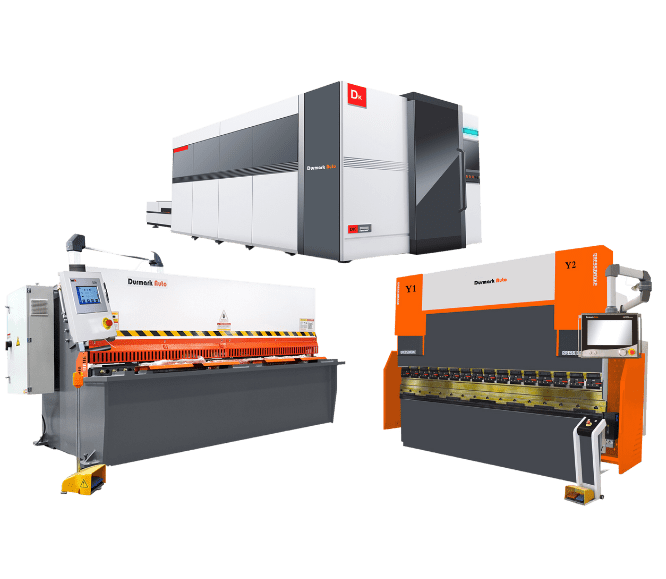
Request a Quote

Request a Quote


Many people often have problems with operation or finished product accuracy when starting their sheet metal business.
Today we will introduce how to improve the precision of the press brake and solve common problems.
Hope it can help you.
If you need to know more information about press brakes, please click to read the article: What is a press brake
A bending machine is a machine used for bending and forming metal. The press brake drives the punch and die through different driving sources.
The mold can repeatedly bend the sheet metal to form a profile, and different thicknesses and lengths of material require different bending forces.
Bending force is the tonnage exerted by the bending machine. press brakes generate tonnage in different ways.
The mechanical bending machine drives the flywheel through a motor. The staff operates the clutch to drive the flywheel of the flight control.
In this way, the crank drives the movement of other components. The operation of the mechanical press brake is relatively simple.
Mechanical press brakes can handle bending of large tonnage.
The Hydraulic press brake is driven by the synchronous movement of hydraulic cylinders.
There is a hydraulic cylinder on each side of the column. The hydraulic cylinder is connected with the ram through the piston rod.
The movement of the hydraulic cylinder drives the slider to move up and down. The movement mode of the Hydraulic press brake is divided into uplink and downlink.
The backgauge accurately positions the workpiece through the movement of different axes. The Hydraulic press brake has the advantages of fast speed and high precision.
The disadvantage is that the bending tonnage is limited.
The CNC press brake is a Hydraulic press brake equipped with a CNC system.
The CNC control system controls the movement of each part. CNC control system has modular programming function and high precision.
Operators can set parameters through the control system. Such as bending angle, plate thickness, flange length, cycle time, stress, etc.
The CNC press brake is also equipped with an automatic feeding system. The movement of the ram and backgauge precisely controls the position of the workpiece.
The motor drives the synchronous movement of the back gauge shaft and the ball screw. The backgauge accurately measures the length of the flange being formed.
Adjust the bending angle by adjusting the movement of the ram through the control system. There are basically three bending methods: air bending, bottom bending and embossing bending.
The choice of bending method has a lot to do with the thickness of the sheet.
Straightness of the clamping opening of the press brake ram (direction Y and direction X).
Repositioning accuracy and arbitrary positioning accuracy of left and right rams.
Whether the gap between the bending machine ram and the frame linear guide is reasonable.
Whether the verticality and inclination of the frame are reasonable.
The connection between the cylinder and the ram.
Strength and precision of frame and ram.
The repositioning accuracy of the backgauge system is arbitrary (X direction and R direction).
Whether the computer system is adjusted well.
Whether the hydraulic system is adjusted in place.
The matching degree of hydraulic system and computer adjustment.
Whether the upper and lower molds are accurate.
Die deformation, damage, wear, and more can affect every aspect of metal bending. Once found, it should be reported and corrected in time.
Inaccurate alignment of the upper and lower molds will lead to deviations in bending dimensions. Make sure the tool is in place during the tool setting process.
After the left and right position of the back gauge moves, the relative distance to the lower die changes. It can be measured with a vernier caliper, and then fine-tuned with the back gauge screw.
Whether the compensation device of the lower mold is accurate and matches the frame design.
The upper mold fixture requires high precision.
The opening size of the V-shaped die is inversely proportional to the bending pressure. When the length and thickness of the sheet are constant, the larger the V-shaped die opening, the smaller the required pressure.
Therefore, when manufacturing workpieces with different thicknesses, the correct V-shaped die opening size should be selected as required.
One end of the bending machine, that is, when the unilateral load is processed, will affect the bending pressure, which is also a kind of damage to the machine, which is expressly prohibited.
When assembling the tooling, the middle part of the machine should always be stressed.
How straight is the sheet metal datum? Is the force on the metal plate uniform? Is the sheet metal thickness consistent?
When bending, the parallelism between the workpiece and the lower mold is not enough, and the workpiece rebounds after the upper mold is pressed down, which affects the bending size.
Material properties and thickness will affect the bending angle, so the initial inspection and random inspection must be strengthened every time the workpiece is bent.
If the press brake is not effectively cleaned for a long time, the accumulated dirt will cause wear and tear on parts and molds.
Some sundries will scratch the workpiece, and the dust in the machine will affect the work of the press brake.
Clean the bending machine and tools before and after using the press brake.
Remove all debris, oil and dust to prevent dust from entering the press brake.
Regular cleaning of the bending machine can prolong the service life of the machine.
Whether the left and right thrusts are consistent when the operator pushes the bending material, or the system data is wrong, and the system is not adjusted properly when using the system.
When the primary bending angle is not enough, it will affect the secondary bending size, and the accumulated bending error will lead to an increase in the error of the outer dimension of the workpiece. The required pressure varies with the length and thickness of the workpiece, and the length and thickness of the sheet are proportional to the pressure. When the length and thickness of the workpiece changes, the bending capacity needs to be changed.
Long-term wear of the guide rail, poor lubrication leads to increased clearance.
It is necessary to check the wear degree of the guide rail and adjust the clearance.
If the wear is severe, the rail pressure plate needs to be replaced.
Failure to lubricate in time will increase the friction between sliding parts.
Automatic or semi-automatic lubrication system to prevent untimely lubrication.
Choose from tin bronze plate or ductile iron. The joint surface is processed by grinding machine.
The connecting bolt is lower than the joint surface, and there is a serrated lubricating oil groove
Long-term bending will cause the slider of the press brake and the middle part of the table to bulge. This protrusion is called deflection, which refers to the amount of protrusion of the ram and the base under the maximum tonnage load. The center of the slider protrudes upwards, and the center of the table curves downwards. And the deflection of the bending machine is limited by the maximum tonnage load. If the load is removed, the slider and table can return to normal condition.
However, if the ram and table are defective, the tonnage load is excessive, which may cause the center of the plunger and table to overturn temporarily or permanently. The distance between the center of the slider and the base is greater than the distance between its two ends. For long workpieces, the central bending angle is greater than the bending angles at both ends.
Obviously, this defect will affect the forming accuracy of curved workpieces and canoe-shaped workpieces. If the tonnage of the machine is adjustable, the load should be adjusted gradually within the rated tonnage range. It is also necessary to equip the machine with a crowning device and use shims to counteract the deflection of the slider.
If the deflection can no longer be compensated, it can only be corrected by reworking the ram and table.
The speed of the ram is too slow when it goes down, which may be caused by the guide rail being too tight. There is no signal from the servo valve, or the axes of the back gauge are not adjusted in place. It is also possible that the plunger did not return to the top position. The filling valve and sealing ring are leaking, or the filling valve is stuck.
Need to check:
If the bending radius is too small, the pressure at the tip of the die will be too high. This can damage the tooling and cause inaccurate bending of the workpiece because different materials have different ductility and tensile strengths.
Take the following measures to avoid tool and workpiece damage:
The bending radius is determined according to the material specifications of each process.
Longitudinal bends have a larger bend radius and transverse bends have a smaller bend radius.
The opening of the workpiece, such as gaps, gaps, etc., is too close to the bending diameter, which will cause deformation of the workpiece.
The distance between the plate opening and the bend line should be at least three times the plate thickness.
Main motor failure, such as loose wiring, control power failure, etc.
Also need to take into account that the emergency stop button is not released.
There are also AC contactor damage, circuit overload, thermal relay, etc.
Check whether the wiring of the switching power supply is loose and whether the emergency stop button is loose.
Whether the circuit has overload protection, and whether other components are damaged.
After bending, cracks will appear on the surface of the workpiece. This is because the bending radius in the mold is too small, the bending gap is too small, or the material itself is defective, and the burrs of the material are facing outward.
Occasionally, the curved end face of the workpiece will be swollen and uneven. This is because the outer surface of the material shrinks and deforms after being stretched. When the inner surface is compressed, it will fold and deform.
It is necessary to improve the finish of the tool and increase the bending radius of the tool. Adjust the bending gap and choose metal materials with good plasticity. Make the mold fillet radius correspond to the external fillet of the part.
The orifice and the valve core are blocked, and the cylinder piston seal ring leaks.
Check whether the throttle valve and spool are blocked, and clear the blockage in time.
Check that the tank filler opening is not covered with hydraulic fluid.
The hydraulic fluid needs to completely fill the tank in order to vent the gas.
Check the piston sealing ring for leakage, and replace the sealing ring in time.
Proper use and maintenance of your press brake will take your business further.
If you are looking for high quality press brake, welcome to contact us.
.png)



